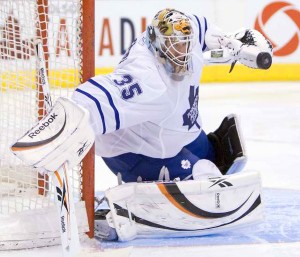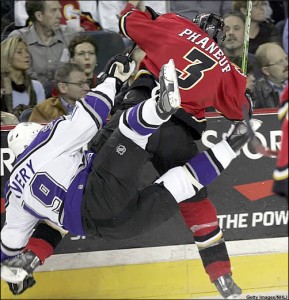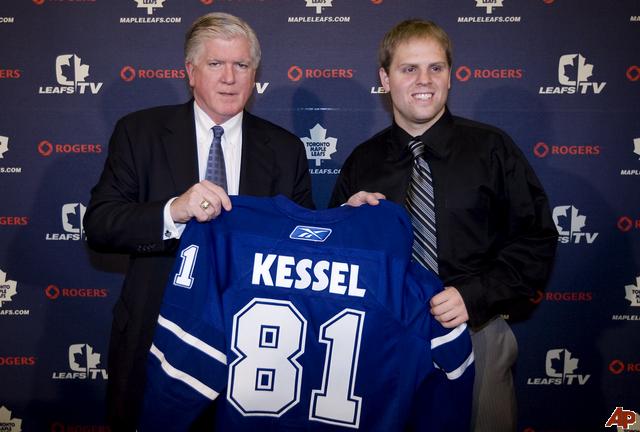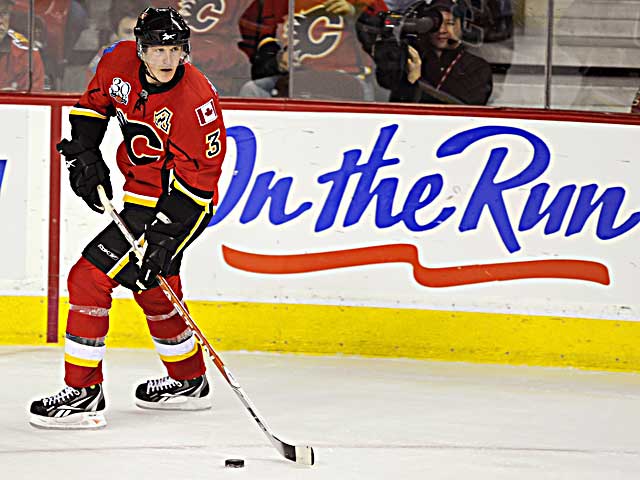Phaneuf gets the headlines, but Giguere wins the games
 I was fortunate enough to attend the Maple Leafs game Tuesday night when Freddie Sjostrom, Dion Phaneuf and Jean-Sebastien Giguere debuted in Toronto’s 3-0 win over the New Jersey Devils.
I was fortunate enough to attend the Maple Leafs game Tuesday night when Freddie Sjostrom, Dion Phaneuf and Jean-Sebastien Giguere debuted in Toronto’s 3-0 win over the New Jersey Devils.
The buzz before the game centred around Phaneuf, but Giguere is going to be the difference maker on this team.
It was apparent after just one period of play. Giguere looked confident in the net, always sure of his decision making.
“Giguere was solid," said head coach Ron Wilson in a press conference after the game. "He’s very professional, incredible focus and concentration out there, that’s what I noticed about him,”
Unlike his predecessor Vesa Toskala or his back-up Jonas Gustavsson, when Giguere makes a save he doesn’t look uncomfortable with the puck. There’s no sense of panic when he has to make a play.
“When we’ve gotten that kind of goaltending we usually play pretty well,” said Wilson. “Everybody settles down, you’re not bobbling pucks as much.”
That staid approach has already affected his teammates. Toronto’s defence has rarely looked this disciplined. Their awareness of the play developing around them was visibly heightened.
The few times that Giguere gave up rebounds the Maple Leafs quickly recovered and cleared the puck out. Most notably, Christian Hanson snapped the puck out of the crease and past the blue-line in the second period after Giguere had made a stop.
“Our defence did a great job in front of him, clearing people and handling rebounds. It was nice that all these guys arrive and they immediately help you out,” said Wilson.
Giguere even helps Toronto on offence, with his superior puck-handling skills creating scoring chances. An outlet pass off the boards from the Quebecois goaltender almost made it 4-0 for the Leafs in the dying minutes of the game.
On the power play, Giguere helped the defence get the puck back into the offensive zone quickly. He made the team more effective in every aspect of the game.
Obviously, Phaneuf made a difference as well.
“Dion got a couple of good hits in early,” said Wilson. “Every time he steps on the ice the other team is looking before they even attempt anything.”
Phaneuf certainly delighted Toronto’s fans by fighting Colin White, but it was Giguere who stole the show, and will continue to be the difference maker for the club.
A 3-0 win is a welcome sight on any team’s record, but this game in particular bodes well for Toronto’s future. Looking at Giguere's sterling stats Tuesday night is all the evidence needed to see that he is the one that will win the Maple Leafs games.
Toronto Maple Leafs take a big step forward by adding Phaneuf and Giguere
As everyone in the hockey world has heard, Brian Burke completed two massive trades Sunday with the Calgary Flames and Anaheim Ducks. Dion Phaneuf and Jean-Sebastien Giguere are the biggest acquisitions made by a Leafs team that looks drastically different from the version that took the ice against the New Jersey Devils Saturday night.
Both trades are intriguing, re-arranging Toronto’s salary cap and improving the Maple Leafs on-ice product in three major ways.
1. Dion Phaneuf adds depth to the Leafs’ blue-line.
Phaneuf was the best player involved in the trade with Calgary. I know it’s a saying that’s been repeated a lot in the wake of these deals, but that doesn’t make it untrue. On paper, Toronto has a fantastic defensive corps with Tomas Kaberle, Francois Beauchemin, Mike Komisarek, Luke Schenn, Carl Gunnarson and now Phaneuf.
The 6’3, 214 pound native of Edmonton will be the kind of physical presence that the Leafs are trying to trademark. Phaneuf will also help Toronto flesh out its power play. Best of all, he’s just 24, meaning he’s got at least a decade left in his career. Definitely a win for Burke.
2. Getting rid of Jason Blake’s outrageously bad shot selection.
Most people have focused on dropping Blake’s 4.5 million per season, but coach Ron Wilson must be thrilled to have the phrases “Blake takes a wristshot from the faceoff circle” and “Blake with the wrap-around attempt” removed from Toronto’s television broadcasts.
The statistics are telling: in the past three years he’s taken 804 shots on goal, scoring 50 times. That’s a 6.2% success rate, folks. Put another way, in his time with the Leafs Blake averaged nearly 4 shots a game, but put the puck in the back of the net once every four games. Think of all the turnovers in that other 75% of games where he was off the mark. If that’s not addition by subtraction, I don't know what is.
3. Jean-Sebastien Giguere is a big improvement over Vesa Toskala.
Giguere has been to the Stanley Cup final twice and won the whole thing a couple of years ago. Although he’s struggled of late, reuniting with goalie coach Francois Allaire should put him on the right path again. In any event, Giggy can definitely be a starting goaltender and also mentor Jonas Gustavsson.
And, you know, it’s best to move on from this beauty:
The one drawback of these deals is the departure of Niklas Hagman, who was Toronto’s best two-way forward. He was the team’s most consistent scorer and always showed a lot of grit on the ice.
However, the good far outweighs the bad for the Toronto Maple Leafs on these trades, and Burke has made some serious moves that will improve Toronto next season without giving up any draft picks, prospects or cap space. Sunday was definitely a banner day in Leafs nation.
Toronto Maple Leafs make huge changes
 It's come out today that Toronto Maple Leafs General Manager Brian Burke has shaken up his team, making two big trades.
It's come out today that Toronto Maple Leafs General Manager Brian Burke has shaken up his team, making two big trades.
First, he sent Slovenian heart-throb Matt Stajan, Ian White, Jamal Mayers and Niklas Hagman to the Calgary Flames for Dion Phaneuf, Fredrik Sjostrom and Keith Aulie.
Then, he sent Vesa Toskala and Jason "Johnny Wristshot" Blake to the Anaheim Ducks for J-S Giguere.
I've got to head off to work shortly, so extensive commentary will have to wait until tomorrow. Right now, it's hard to tell if the Leafs are better or worse, but they are certainly different.
Phil Kessel cost the Leafs too much
 The Toronto Maple Leafs edged the Nashville Predators 4-3 Monday night, getting a late game-winning goal from young Phil Kessel, Brian Burke’s shiny acquisition, the cornerstone of the Age of Truculence.
The Toronto Maple Leafs edged the Nashville Predators 4-3 Monday night, getting a late game-winning goal from young Phil Kessel, Brian Burke’s shiny acquisition, the cornerstone of the Age of Truculence.
Since he started playing for the Leafs (about six weeks after the trade that brought him to Toronto from Boston) he has scored 15 goals and 13 assists, and is easily the best player on the Leafs.
But I think the trade has been a terrible mistake. He doesn’t have enough help on the ice, he’s not a franchise player, and ultimately, the price was too high for Toronto.
Don’t get me wrong, he is a great player. He finds open space, sees plays developing and makes intelligent decisions with the puck. He can score from anywhere in the offensive zone and demands that the other team cover him tightly, giving his teammates room to breathe.
Unfortunately, his teammates don’t seem to know what to do with that space. As a result, opposing defences have begun to take advantage of the Leafs lack of depth. They have, as defensive coaches say, begun to cheat on Kessel.
Defensive strategy relies heavily on reactive responses to an offence. Obviously, a good defence reacts to where the puck is, where the players are. But because Toronto does not have a strong secondary scoring threat, defences have taken to sealing off Kessel as soon as he’s on the ice. They know that should he pass the puck, the Leafs probably aren’t going to be able to score.
Now, there are some players who would be able to overcome that, who could make the players around them better. The kind of players that only need to be identified by their surnames: Gretzky, Lemieux, Crosby, Ovechkin, Brodeur, Roy. Unfortunately, Kessel just doesn’t belong there. He’s a very good hockey player, but his shoulders aren’t broad enough to carry an entire franchise.
And that, ultimately, is why trading two first round picks and a second round pick was too much for Kessel.
That’s an awfully high price, jeopardizing the Leafs for the next five or more years. Frankly, I’m not sure that I’d trade that much for any of the franchise players mentioned above, let alone Phil Kessel.
With the Leafs toiling near the bottom of the standings, the trade looks even worse. There’s a good chance that the division rival Boston Bruins landed themselves a top three pick that could mean Taylor Hall or Tyler Seguin, both quality players that would’ve helped the Leafs considerably, and at the rookie maximum salary instead of Kessel’s $27 million over five years.
When there were rumours that Toronto was going to trade with the Boston Bruins, that Burke might land Kessel, a proven sniper, I was ecstatic. At last, the Leafs were going to start to turn it around. Most people I knew thought that too, but my good friend Ruben and my dad both held out, saying that it was a bad trade. It took me a while, but now I see it too. Phil Kessel is a quality player, but the price the Maple Leafs paid was way too high.
